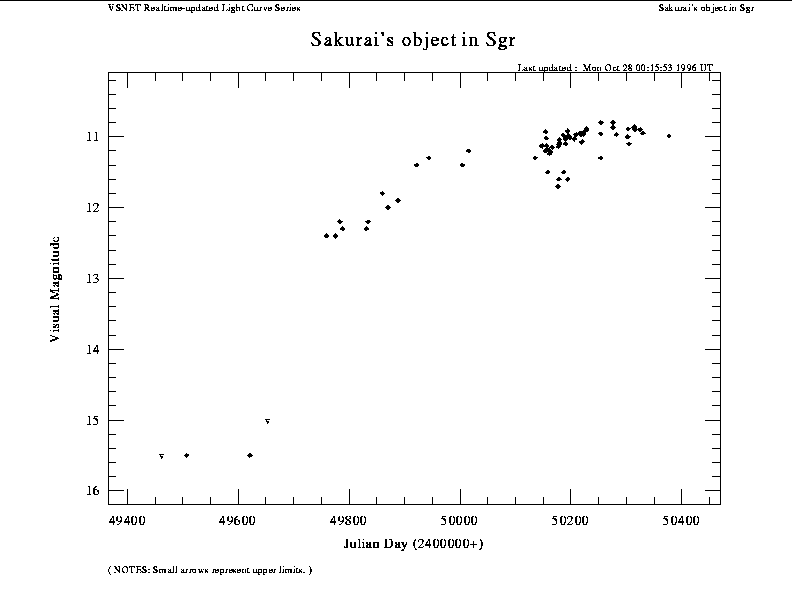 Dramatic change in spectrum (1997 Mar.)
Dramatic change in spectrum (1997 Mar.)
IAUC No. 6322 (D. Green) tells that Sakurai, Ibaragi, Japan discovered a possible "slow" nova in Sagittarius.
17h 52m 33s.5 -17o 40' 52" (J2000.0)
He estimated the object at photographic (Fuji G400 film) magnitude of 11.4 on Feb, 20.806 UT. The object seems to have started brighten at around 1995 Jan., when it was 12.5.
S. Benettei and H. W. Duerbeck report s spectrum taken by E. Cappellaro show a reddened early G-star with no prominent emission components. It may be a "slow" nova or a symbiotic nova.
Y. Kushida (IAUC 6223) reports an accurate astrometry of this object.
17h 52m 32s.69 -17o 41' 07".7 (J2000.0)
(vsnet-alert 341)
Prediscovery observations of possible slow nova in Sgr (Sakurai)
Following photographic magnitude estimates have been reported by K. Takamizawa, VSOLJ).
Photographic magnitude estimates by VSOLJ members object YYMMDD(UT) mag code SGRSakurai1996 940414.662 <155P Tmz.VSOLJ SGRSakurai1996 940603.655 155P? Tmz.VSOLJ may be an emulsion grain SGRSakurai1996 940925.471 155P? Tmz.VSOLJ may be an emulsion grain SGRSakurai1996 941022.403 <150P Tmz.VSOLJ SGRSakurai1996 950210.812 124P Tmz.VSOLJ SGRSakurai1996 950226.786 124P Tmz.VSOLJ SGRSakurai1996 950306.762 122P Tmz.VSOLJ SGRSakurai1996 950311.753 123P Tmz.VSOLJ SGRSakurai1996 950423.708 123P Tmz.VSOLJ SGRSakurai1996 950426.748 122P Tmz.VSOLJ SGRSakurai1996 950522.643 118P Tmz.VSOLJ SGRSakurai1996 950601.631 120P Tmz.VSOLJ SGRSakurai1996 950619.612 119P Tmz.VSOLJ SGRSakurai1996 950723.566 114P Tmz.VSOLJ SGRSakurai1996 951013.435 114P Tmz.VSOLJ SGRSakurai1996 951025.391 112P Tmz.VSOLJ SGRSakurai1996 960221.803 113P Tmz.VSOLJ Observer's code: Tmz: K. Takamizawa 10-cm refr. F4 T-max 400
In IAUC No. 6325, S. Benetti is reporting high-resolution spectra, which showed pure absorption lines of He, C, N etc. From the slow brightening and spectral features, they suggest that the variable may represent a final helium shell flash as has been suggested for explanation of the V605 Aql (Nova Aql 1919) event. This suggestion has been supported by the discovery of a planetary nebula which had been presumably ejected from this object (cf. IAUC 6328 Duerbeck and Pollacco: press release).
 Dramatic change in spectrum (1997 Mar.)
Dramatic change in spectrum (1997 Mar.)

 Wide field chart
Wide field chart
 Surroundings with GSC magnitudes
Surroundings with GSC magnitudes
 Close-up with magnitudes to the GSC limit
Close-up with magnitudes to the GSC limit
 VSNET-format chart with GSC magnitudes
VSNET-format chart with GSC magnitudes
 GSC and CLAS objects near the variable
GSC and CLAS objects near the variable


(Ouda Station, V-band CCD images)


(from CCD images taken at Ouda Station,
by Daisaku Nogami)
